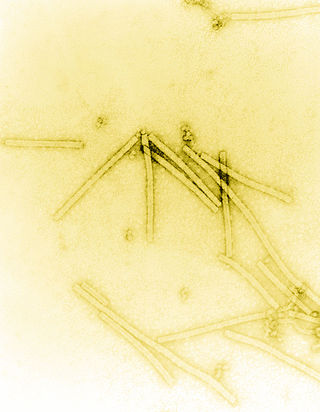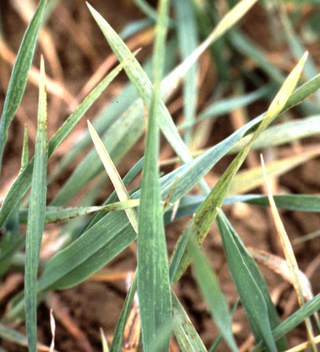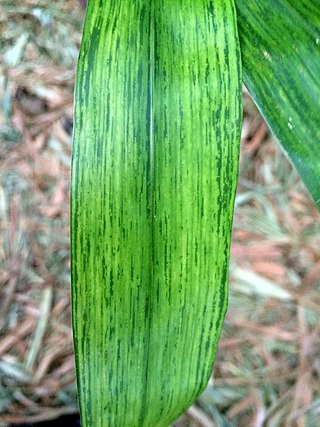
Tobacco mosaic virus (TMV) is a positive-sense single-stranded RNA virus species in the genus Tobamovirus that infects a wide range of plants, especially tobacco and other members of the family Solanaceae. The infection causes characteristic patterns, such as "mosaic"-like mottling and discoloration on the leaves. TMV was the first virus to be discovered. Although it was known from the late 19th century that a non-bacterial infectious disease was damaging tobacco crops, it was not until 1930 that the infectious agent was determined to be a virus. It is the first pathogen identified as a virus. The virus was crystallised by W.M. Stanley. It has a similar size to the largest synthetic molecule, known as PG5.

Brome mosaic virus (BMV) is a small, positive-stranded, icosahedral RNA plant virus belonging to the genus Bromovirus, family Bromoviridae, in the Alphavirus-like superfamily.

Tobamovirus is a genus of positive-strand RNA viruses in the family Virgaviridae. Many plants, including tobacco, potato, tomato, and squash, serve as natural hosts. Diseases associated with this genus include: necrotic lesions on leaves. The name Tobamovirus comes from the host and symptoms of the first virus discovered.

Lettuce mosaic virus (LMV) is a typical potyvirus, which causes one of the major virus diseases of lettuce crops worldwide.

Papaya ringspot virus (PRSV) is a pathogenic plant virus in the genus Potyvirus and the virus family Potyviridae which primarily infects the papaya tree.

Alfalfa mosaic virus (AMV), also known as Lucerne mosaic virus or Potato calico virus, is a worldwide distributed phytopathogen that can lead to necrosis and yellow mosaics on a large variety of plant species, including commercially important crops. It is the only Alfamovirus of the family Bromoviridae. In 1931 Weimer J.L. was the first to report AMV in alfalfa. Transmission of the virus occurs mainly by some aphids, by seeds or by pollen to the seed.

Turnip yellow mosaic virus (TYMV) is an isometric Tymovirus of the family Tymoviridae. Its host range is confined almost entirely to plants in the genus Brassica in western Europe, which includes cabbages, cauliflower and broccoli. Infection causes bright yellow mosaic disease showing vein clearing and molting of plant tissues.

Cassava mosaic virus is the common name used to refer to any of eleven different species of plant pathogenic virus in the genus Begomovirus. African cassava mosaic virus (ACMV), East African cassava mosaic virus (EACMV), and South African cassava mosaic virus (SACMV) are distinct species of circular single-stranded DNA viruses which are transmitted by whiteflies and primarily infect cassava plants; these have thus far only been reported from Africa. Related species of viruses are found in India and neighbouring islands, though cassava is cultivated in Latin America as well as Southeast Asia. Nine species of cassava-infecting geminiviruses have been identified between Africa and India based on genomic sequencing and phylogenetic analysis. This number is likely to grow due to a high rate of natural transformation associated with CMV.

Barley yellow mosaic virus is plant pathogenic virus that causes the yellow mosaic disease of barley. Its shape is categorized as being flexuous filamentous, with lengths of 275 and 550 nanometers. The virus has a limited host range, and barley appears to be the only known susceptible host. The virus is transmitted via Polymyxa graminis, which is a plasmodiophorid protist, through the resting spores that survive in the soil, and eventually zoospores. Eastern Asia is the most affected region, but the virus can be found worldwide. Current agricultural practices have been ineffective at eliminating the virus, but breeding resistance appears to be the only way to help reduce the disease.
Bean yellow mosaic virus is a plant pathogenic virus in the genus Potyvirus and the virus family Potyviridae. Like other members of the Potyvirus genus, it is a monopartite strand of positive-sense, single-stranded RNA surrounded by a capsid made for a single viral encoded protein. The virus is a filamentous particle that measures about 750 nm in length. This virus is transmitted by species of aphids and by mechanical inoculation.

Cucumber mosaic virus (CMV) is a plant pathogenic virus in the family Bromoviridae. This virus has a worldwide distribution and a very wide host range, having the reputation of the widest host range of any known plant virus. It can be transmitted from plant to plant both mechanically by sap and by aphids in a stylet-borne fashion. It can also be transmitted in seeds and by the parasitic weeds, Cuscuta sp. (dodder).
Panicum mosaic virus (PMV) is a positive-sense single-stranded RNA viral pathogen that infects plant species in the panicoid tribe of the grass family, Poaceae. The pathogen was first identified in Kansas in 1953 and most commonly causes disease on select cultivars of turf grass, switchgrass, and millet. The disease most commonly associated with the panicum mosaic virus pathogen is St. Augustine Decline Syndrome, which infects species of turf grass and causes chlorotic mottling. In addition to St. Augustine Decline, panicum mosaic virus is responsible for chlorotic streaking and mild green mosaicking in select cultivars of switchgrass and millet.

Prunus necrotic ringspot virus (PNRSV) is a plant pathogenic virus causing ring spot diseases affecting species of the genus Prunus, as well as other species such as rose and hops. PNRSV is found worldwide due to easy transmission through plant propagation methods and infected seed. The virus is in the family Bromoviridae and genus Ilarvirus. Synonyms of PNRSV include European plum line pattern virus, hop B virus, hop C virus, plum line pattern virus, sour cherry necrotic ringspot virus, and peach ringspot virus.
Tomato ringspot virus (ToRSV) is a plant pathogenic virus of the family Secoviridae. It affects species of cucumber, tobacco, tomato, cowpea, among others. It causes ringspots in tobacco plants and raspberries, yellow bud mosaic in peaches, yellow vein in grapes, and stunted growth in gladiolus and Narcissus. Its range is in the temperate regions of North America, especially where its vector, Xiphinema americanum is present. Along with the adult and larval stages of this nematode, the virus is also spread by seed. This type of infection is more common in strawberries and soybeans than any other susceptible plant.

Sugarcane mosaic virus (SCMV) is a plant pathogenic virus of the family Potyviridae. The virus was first noticed in Puerto Rico in 1916 and spread rapidly throughout the southern United States in the early 1920s. SCMV is of great concern because of the high economic impact it has on sugarcane and maize.

Celery mosaic virus (CeMV) is a plant pathogenic virus in the genus Potyvirus and the virus family Potyviridae .

Bamboo mosaic virus (BaMV) is a plant pathogenic virus in the genus Potexvirus and the family Alphaflexiviridae. BaMV is a filamentous, flexuous rod, 490 nm in length and 15 nm in width. The virus has been fully sequenced and it is 6366 nucleotides long.

Betaflexiviridae is a family of viruses in the order Tymovirales. Plants and fungi serve as natural hosts. There are 108 species in this family, assigned to 13 genera in two subfamilies. Diseases associated with this family include mosaic and ringspot symptoms.

Watermelon mosaic virus (WMV) also known as Marrow mosaic virus, Melon mosaic virus, and until recently Watermelon mosaic virus type 2 (WMV-2), is a plant pathogenic virus that causes viral infection in many different plants. The virus itself is referred to as Watermelon Mosaic Virus II or WMV-2 and is an isolate of the U.S. WMV-2 is a ssRNA positive strand virus that is part of the Potyviridae or Potyvirus clade. Like all RNA viruses, it contains a protein capsid which protects the inner viral RNA. First described on squash in Florida, WMV arose from a unique recombination of genetic material contributed by Soybean mosaic virus (SMV) and Bean common mosaic virus (BCMV) along with Peanut Stripe virus (PSV).

Abutilon mosaic virus (AbMV) is a virus of the genus Begomovirus. It infects Abutilon species, notably the flowering maple, Abutilon striatum. The mottled or variegated effect on the leaves of Abutilon striatum is sought after.
















